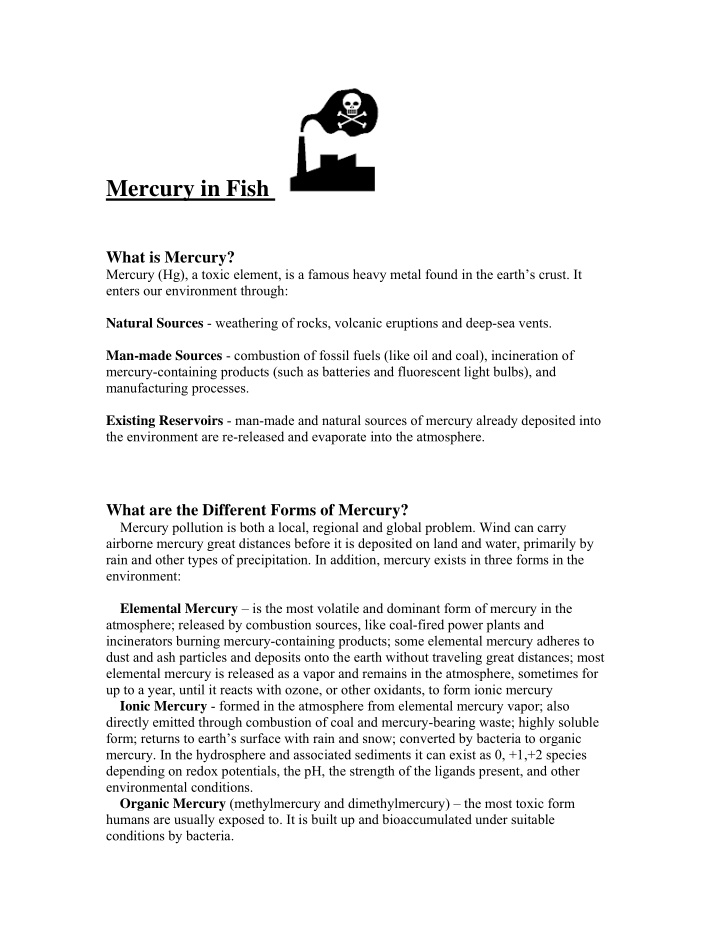



Mercury in Fish What is Mercury? Mercury (Hg), a toxic element, is a famous heavy metal found in the earth’s crust. It enters our environment through: Natural Sources - weathering of rocks, volcanic eruptions and deep-sea vents. Man-made Sources - combustion of fossil fuels (like oil and coal), incineration of mercury-containing products (such as batteries and fluorescent light bulbs), and manufacturing processes. Existing Reservoirs - man-made and natural sources of mercury already deposited into the environment are re-released and evaporate into the atmosphere. What are the Different Forms of Mercury? Mercury pollution is both a local, regional and global problem. Wind can carry airborne mercury great distances before it is deposited on land and water, primarily by rain and other types of precipitation. In addition, mercury exists in three forms in the environment: Elemental Mercury – is the most volatile and dominant form of mercury in the atmosphere; released by combustion sources, like coal-fired power plants and incinerators burning mercury-containing products; some elemental mercury adheres to dust and ash particles and deposits onto the earth without traveling great distances; most elemental mercury is released as a vapor and remains in the atmosphere, sometimes for up to a year, until it reacts with ozone, or other oxidants, to form ionic mercury Ionic Mercury - formed in the atmosphere from elemental mercury vapor; also directly emitted through combustion of coal and mercury-bearing waste; highly soluble form; returns to earth’s surface with rain and snow; converted by bacteria to organic mercury. In the hydrosphere and associated sediments it can exist as 0, +1,+2 species depending on redox potentials, the pH, the strength of the ligands present, and other environmental conditions. Organic Mercury (methylmercury and dimethylmercury) – the most toxic form humans are usually exposed to. It is built up and bioaccumulated under suitable conditions by bacteria.
Why is Mercury Important to US? Because airborne mercury can be carried by wind for great distances, mercury is an extremely widespread pollutant, contaminating remote lakes once thought to be pristine hundreds of miles from the nearest mercury source. Through deposition, airborne mercury in the air can fall on the ground or enter aquatic environment. Then bacteria convert mercury to methylmercury derivatives. Then they can be taken up into the food chain and ultimately the fish and seafood we eat. Bioaccumulation of mercury is extremely efficient in the aquatic food chain. It is discovered that fish at the highest trophic level has highest amount of mercury in its body tissues about one million times higher than the mercury concentration in the water. Levels of mercury in rainwater are in the range 5–100 ng/L. Naturally occurring levels of mercury in groundwater and surface water are less than 0.5 μ g/L, although local mineral deposits may produce higher levels in groundwater. An increase in the mercury concentration up to 5.5 μ g/L was reported for wells in Izu Oshima Island (Japan), where volcanic activity is frequent. The concentration range for mercury in drinking-water is the same as in rain, with an average of about 25 ng/L. There have been no reports of methylmercury being found in drinking-water. Who is at Risk from Mercury Exposure? Eating contaminated fish is the major source of human exposure to methylmercury. The population most at risk is fetuses, infants, and young children. Consequently, fish consumption by pregnant women, young children, and women of childbearing age (ages 15-44) is cause for concern because of the likelihood of mercury exposure. In addition, people who eat a lot of commercial fish or seafood, and people who rely on self-caught fish such as Native Americans and other subsistence fishers can also be highly exposed. Methylmercury can threat to ecosystems as well. It was found alarmingly high levels of mercury in some endangered fish-eating birds and mammals such like bald eagle, dolphins, and killer whales. Mercury poisoning has also contributed to the death of terrestrial mammals such as polar bear which mainly prey on seals. Health Effects from Eating Mercury Contaminated Fish Mercury is a potent neurotoxin. Because of the properties of high lipophiic and bioconcentratable, methyl mercury derivatives have greater toxicity than other forms. Consumption of contaminated fish is the major route of human exposure to methylmercury. Accumulated mercury is unevenly distributed in various organs in the body. It is mercury in the brain that leads to the neurological dysfunctions. Methylmercury is also a developmental neurotoxicant. It is particularly hazardous to developing fetuses, infants and young children, with resulting effects including delays in learning motor functions (walking, talking and speaking). Methylmercury transfers from women to fetuses across the placenta and to infants through breastfeeding. It will cause serious problem on brain development.
Any Solutions of this Problem? -Please think about any possible solution for our mercury food contamination.
Recommend
More recommend